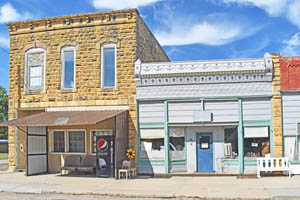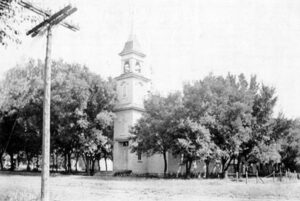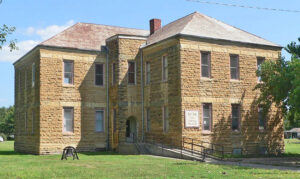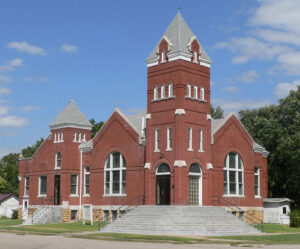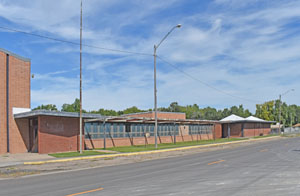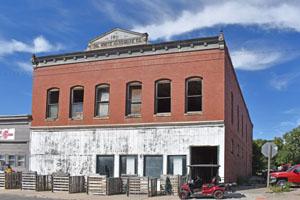Burr Oak, Kansas, located in Burr Oak Township of Jewell County, is on White Rock Creek about 11 miles northwest of Mankato, the county seat. As of the 2020 census, the city’s population was 140, and its total area was 0.83 square miles, all land.
Burr Oak was settled in 1870 by A.W. Mann, Zack Norman, Lee Tingley, Thomas Richard Comstock, James M. McCormick, Frank Gilbert, A.J. Godfrey, D.H. Godfrey, Allen Ives, John E. Faidley, G. Beanblossom, and F.E. Blake. A.J. Godfrey built the first house on what is now State Street.
John F. Faidley, who arrived in October 1870, kept the first store with a large stock of merchandise. He also owned 2,000 acres of land in Jewell County and had an interest in a hardware and farm implement establishment.
The Dunkards, or German Baptists, were organized in October 1870 by Reverend Allen Ives. Burr Oak, Limestone, and White Rock were included in the same organization. By the early 1880s, their membership was over 350 people, who met in tents measuring 50×90 feet in the spring, summer, and autumn.
In May 1871, Reverend Allen Ives preached the first sermon at A.J. Godfrey’s. The following month, the post office was established on June 2, 1871, with James M. McCormick, a former Union soldier in the Civil War, serving as the first postmaster. Later, he held the office of Township Clerk, Trustee, and Justice of the Peace. The town was named from the Burr Oak Creek.
The post office was established on June 2, 1871.
A.J. Godfrey laid out the town on the NW 1/4 of the NW 1/4 of Section 23, Township 2, south, Range 3, west, in May 1872. Originally from Michigan, Godrey was a druggist and grocer who served in the Union Army during the Civil War. He served as a county commissioner and the first Justice of the Peace in Burr Oak Township.
The Methodists were the first to establish a congregation in Burr Oak. It was organized by Reverend H.G. Breed in 1873 to fulfill the need for a community church. Until 1880, Methodist Church meetings were held in various homes and buildings.
On May 22, 1873, John Faidley took Frank Gilbert into partnership with him, and the firm became known as Faidley & Gilbert. Originally from Pennsylvania, Gilbert was first engaged in the grocery business in 1872.
B.F. Royer, who had come to Burr Oak from Illinois in 1872, established a wagon and blacksmith shop in the spring of 1873.
In October 1873, B.H. Johnson, a druggist from Minnesota, arrived and engaged in the hardware business. The same year, in the winter of 1873, W.H. Kemp taught the first school.
Beginning in 1875, Burr Oak made a more rapid growth than any place in the county. It had a larger population and did more business because it was the terminus of a railroad and had the trade of a vibrant and well-settled district.
A.W. Mann, a merchant from Iowa, came to Jewell County in May 1870 and engaged in the drug business in the fall of 1875. Two years later, he also engaged in general merchandising under the firm name of McLain & Mann. Afterward, the firm was changed to Mann, Faidley & Gilbert. He held the office of Justice of the Peace and was the second Justice of the Peace in Burr Oak Township after the organization of the county.
E.O.W. Smith, who homesteaded near Burr Oak in 1872, went into the restaurant business in 1877.
By 1878, Burr Oak Township was one of the best in the county and was thickly settled by as good a class of citizens. The township had six school districts with good schoolhouses and regular school terms. There were three Sunday Schools. The religious denominations included Methodists, Friends, United Brethren, Dunkards, Saturday and Sunday Advents, Christians, Presbyterians, and Spiritualists, all of which had regular preaching.
On March 18, 1878, the Faidley & Gilbert store partnered with A.W. Mann, and the firm became known as Mann, Faidley & Co. The business carried a heavy stock of general merchandise in a room 24×50 feet with an upper floor of the same size.
In May 1878, B.H. Johnson engaged in the drug business in his store building, measuring 22×44 feet. He held the office of Justice of the Peace and Assessor and Township Clerk of Burr Oak Township.
The same year, Doctor J.E. Hawkey moved to Burr Oak from Nebraska. After holding the office of City Councilman for two years, he was elected Mayor of the city in April 1882.
At that time, the town of Burr Oak boasted two general stores, a drug store, a harness shop, a water saw and grist mill, a sewing and reaping machine establishment, two hotels, and a population of 659.
The Burr Oak Reveille newspaper was established on January 1, 1879, by H.E. Taylor. It was purchased by W.E. Bush in 1880. It was suspended in August 1882 and was reorganized in October by a joint stock company but continued under the same management. It was a seven-column folio independent of politics and enjoyed good circulation.
The first school was established following the Missouri Pacific Railroad’s arrival in 1879 and subsequent boom in population.
In 1879, the Cornet Band, with ten pieces, was organized under the leadership of R.W. Johnson.
The Baptist Church was organized in September 1879 by Reverend Howard. The society soon purchased and remodeled the old schoolhouse for its accommodation, with H.D. Babcock as the first pastor. By the early 1880s, it was led by Reverend S. Shutz and had about 25 members.
M. Weil, a French merchant, moved from Muscotah, Kansas, to Burr Oak in January 1880 and opened a store in a room 22×80 feet and carried a stock of from $16,000 to $18,000.
Burr Oak was incorporated as a city of the third class in April 1880; the first officers were J.K. McLain, Mayor; W.M. Spurlock, city clerk; A.W. Mann, treasurer; T.W. Carpenter, O.F. Roberts; A.J. Godfrey, George Quigley, and Dr. J.E. Hawley, councilmen.
That month, trustees were appointed to start plans for building a Methodist Church, and by the following year, the town had contributed enough money to provide for the building. A lot was purchased at the northeast corner of Pennsylvania and Washington Streets, and the foundation was laid for a 30-foot by 50-foot wooden frame building. It was built for $2,300. A vestibule and steeple were added to the church after its construction. Under Reverend Mr. Breed, there was a revival in the winter of 1880-81, which secured 40 members to the church. Before long, its total membership was about 110.
In the same year, E.O.W. Smith engaged in general merchandising under the name Faidley, Hollenbeck & Smith and had a flourishing business.
By the early 1880s, Burr Oak was the largest and most prosperous town in the county, and Jewell County had become the “Banner Corn County in Kansas.”
The introduction of the Central Branch of the Missouri Pacific Railroad in the mid-1880s boomed the town.
The church and school privileges were good. An elegant, spacious school building with three grades had just been completed for $3,500. There were four religious denominations in Burr Oak – the Baptist, Methodist, Dunkard, and Catholic. The Catholic Church was last organized in 1881 by Reverend J. Perrier of Concordia. There were 15 families in the parish, and they had an $800 church.
In 1881, J.W. Green opened a furniture store under the firm name of Green & Carpenter. He had come to Jewell County in the fall of 1873 and took a homestead five miles northwest of Burr Oak.
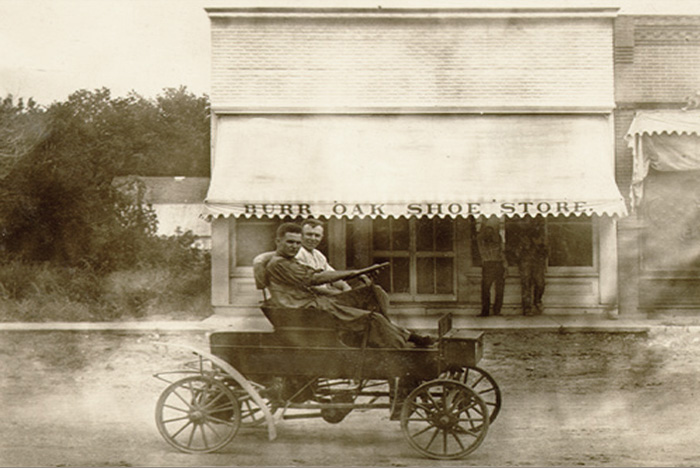
Burr Oak, Kansas Store.
The same year. Doctor H. Hannum and Dr. Thomas Kirk, Jr., from Pennsylvania, arrived and engaged in the practice of medicine. Thomas Tweedy, an attorney, also began his practice in 1881.
In 1882, P.B. Spears, originally from Indiana, erected a brick bank building 24×50 feet, two stories high, and furnished in first-class style.
The same year, B.F. Royer bought the livery, barn, and stock of O.B. Ford in Burr Oak and engaged in the livery business. He served as the Treasurer of Burr Oak Township for seven years, City Marshal for one year, and was a City Council member.
N.S. Stewart, a hardware merchant, moved to Burr Oak from Jackson County, Minnesota, came to Jewell County, Kansas, in 1872, and clerked for McLain in the implement business for five years. In May 1882, he engaged in the hardware business named Faidley Bros. & Stewart. Mr. Stewart. The firm became one of the best in Burr Oak and did a flourishing business.
The second school was filled by 1898, forcing some students to attend classes in the G.A.R. building across the street. Understandably, the residents of Burr Oak voted almost unanimously to build a new school, which they did on land that the town’s founder, A.J. Godfrey, had donated to the school district. Renowned Topeka architect for the Kansas State Capitol, J.C. Holland, designed the Burr Oak School, and J.W. Berry constructed the new Romanesque schoolhouse for $7,000. It was built in 1899 out of limestone quarried from the Randall area, about 30 miles north. The school opened its doors on January 2, 1900.
In 1910, Burr Oak was still a station on the Missouri Pacific Railroad and was connected with Otego by daily stagecoach. At that time, it had banking facilities, an opera house, a hospital, a fire department, a weekly newspaper, churches and schools, express and telegraph offices, and a post office with four rural mail routes. Grain and livestock were the principal products shipped. That year, Burr Oak’s population peaked at 746.
By this time, the Methodist congregation had outgrown its white-frame church, and members decided they needed a larger structure. A new building, which had been under consideration for several years, was decided upon on December 4, 1911. The original frame building was moved across the street for $75.00 and was sold to the Nazarene congregation, which would later move the church to its present location, two blocks east on Jewell Street.
J.C. Holland drafted the church’s design, and M. E. Brady, from nearby Beloit, Kansas, was chosen as the builder. In 1912, the two-story, red brick and limestone church was completed on the northeast corner of Pennsylvania and Washington Streets. With its gabled roof and two towers, the new church included a sanctuary, Sunday school, baptistery, large basement, kitchen, furnace/coal room, and study and reading room. The main sanctuary was arranged to seat about 225 people. The total cost of construction of the church was $16,000. The building was added to the National Register of Historic Places in 2007.
High school classes were held in the new school until 1916, when a new high school was built. However, the building operated as a grade school until 1967. The grounds also served as a community meeting place when classes were out of session in the summer months.
After the Great Depression and during the Second World War, Jewell County’s population swiftly declined to 4,270 by 1940.
Between 1940 and 1950, the county’s population dropped again.
When the school moved operations to a newer building in 1967, Burr Oak residents voted to allow the city to purchase the empty limestone school building, hoping that the city would keep the structure from falling into disrepair. The building then served as a library and museum. It was listed on the National Register of Historic Places in December 2005; it is located at 776 Kansas Street in Burr Oak.
In 1977, the Methodist Church joined the Jewell County Parish. It currently has a small but active membership. The church is also used for community events, including kindergarten classes, 4-H meetings, Bible studies, children’s religious gatherings, funeral services, and wedding receptions.
School unification consolidated Burr Oak and Esbon schools forming White Rock schools in 1983. The White Rock elementary school and high school were located in Burr Oak.
Burr Oak became a part of Rock Hills USD 107, located in Mankato, in 2006.
Burr Oak is located about ten miles northwest of Mankato.
© Kathy Alexander/Legends of America, October 2024.
Also See:
Sources:
The Clio
Blackmar, Frank W.; Kansas: A Cyclopedia of State History, Vol I; Standard Publishing Company, Chicago, IL 1912.
Cutler, William G; History of Kansas; A. T. Andreas, Chicago, IL, 1883.
Facebook
History of Jewell County, Kansas, by M. Winsor and James A. Scarbrough, Diamond Printing Office, 1878.
Kansas Genealogy
Kansas Genweb
Kansas Guidebook
National Register of Historic Places
Scarbrough, James A. and Winsor, M., History of Jewell County, Kansas, Diamond Printing Office, Jewell City, Kansas, 1878.
Wikipedia



